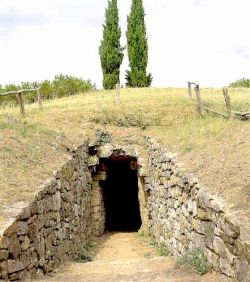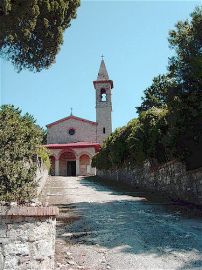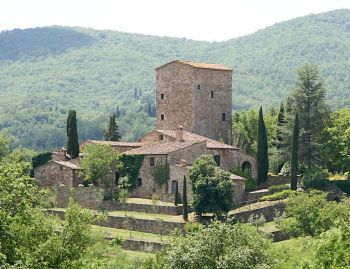History of Castellina in Chianti
The origins of Castellina in Chianti go back until the 7th century B.C. A whole series of Etruscan villages and hamlets once existed along a major route following the crest that passes through Castellina and provided a link between the great cities of maritime Etruria – Vulci, Vetulonia and Roselle – and the markets of the north, particularly Spina, the most important trading harbour on the Adriatic and the gateway to the East.
Many important archaeological finds have come to light in Castellina, particularly the imposing burial vault of Mt. Calvario, which measures about 53 metres across, just outside the town on the road to Florence. The tomb contains four burial vaults arranged in a cross aligned with the four cardinal points. The hill takes its name from a little chapel that once stood on the summit, the last station of the Way of the Cross.
At Poggino, to the east of the village of Fonterutoli, along the old road towards Siena, archaeologists have unearthed a small necropolis containing five tombs, four with burial chambers and one small rectangular chamber shaped like a chest. Artifacts found among the burial objects show that rich families of noble birth lived in this region throughout the 6th century B.C., the Etruscan period of greatest splendour which, according to Diogenes of Halicarnassus, "has no peer". Castellina continued as a settlement in Roman times up until the 1st century B.C. but traces of sudden destruction followed by a fire indicate that the town came to a tragic end.
At Poggino, to the east of the village of Fonterutoli, along the old road towards Siena, archaeologists have unearthed a small necropolis containing five tombs, four with burial chambers and one small rectangular chamber shaped like a chest. Artifacts found among the burial objects show that rich families of noble birth lived in this region throughout the 6th century B.C., the Etruscan period of greatest splendour which, according to Diogenes of Halicarnassus, "has no peer". Castellina continued as a settlement in Roman times up until the 1st century B.C. but traces of sudden destruction followed by a fire indicate that the town came to a tragic end.
Castellina came to prominence in the mediaeval period as witnessed not just by the structures in Castellina itself but also the many magnificent fortified farm houses and tower houses dotted through the territory. The Cassero di Grignano, for example, overlooks a bridge that crosses the Cerchiaio gully and the Pesa stream, thereby controlling commercial traffic between Castellina and Panzano, and thus also between Sienna and Florence. Pietrafitta and Grignano are mentioned in a donation made by Marchese Ugo to the Marturi Abbey in 998.
Castellina was a border between the powerful Etruscan lucumon-ruled territories of Volterra, Chiusi and Fiesole, which were in both political and cultural opposition. The ancient border is reflected today in the division of the Castellina region between the dioceses of Siena and Fiesole. The town of Castellina in its current location is probably of Roman origin but any traces have been lost over the centuries. Castellina's military importance probably increased dramatically during the 11 C when a Castellina dei Trebbiesi is mentioned, a name derived from the nobles of Trebbio, members of the alliance of the Conti Guidi, owners of a castle nearby of which the remains are visible at Badiola. During the 12 C, Castellina played a military role within the Chianti Alliance mainly because of its strategic location, which guaranteed the control of all the surrounding roads as well as the entire valley of the Elsa river. Evidence of the town’s importance during this period is its imposing fortress, built in severe style. The entire town was surrounded by massive walls and towers, with only two gates providing access, one towards Sienna, the other Florence. Unfortunately both gates were completely destroyed, the Florence gate during the Second World War. Most of the walls still stand today, although houses have been built right up against them in numerous places. These defences witnessed centuries of battles, sieges and clashes. The battles had alternating outcomes. Alberico da Barbiano, in the service of the Duke of Milan, took Castellina by storm in 1397. The troops of Ferdinando d’Aragon failed in their attempt to do the same in 1452 and withdrew after a 44-day siege. The town was stormed in 1478 after a lengthy siege by the Duke of Calabria, despite Lorenzo the Magnificent, who then ruled Florence, having despatched the famous architect Giuliano da Sangallo to Castellina to strengthen the town’s defences.
More history of Chianti.
More history of Chianti.



